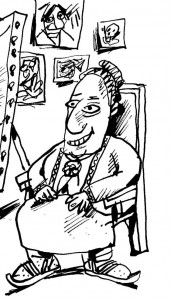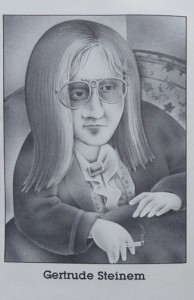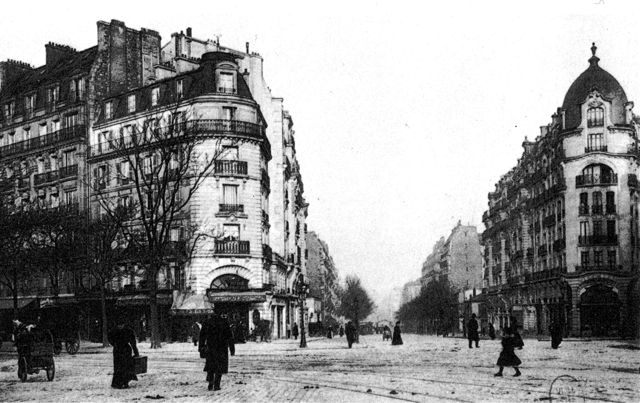A sketch by Tom Hachtman/>
 Aquarie Gertrude comes up for another spin around the virtual sun of birthdays this very day today. And a great birthday it is. 2011 is promising a big comeback for Stein — in the California of her youth, of all places. San Francisco is preparing the unusual festivities: two major exhibitions focused on Stein. And for the first time ever in this city, two museums are coordinating their efforts and their programming to present the multiple facets of their topic. At the Contemporary Jewish Museum, the focus is on Stein’s personality. “Seeing Gertrude Stein: Five Stories” will show Stein in a way she has never yet been shown — through her domestic life, the art of friendship, her celebrity, her survival during the war, and her legacy. Here is how the museum presents this unique project:
Aquarie Gertrude comes up for another spin around the virtual sun of birthdays this very day today. And a great birthday it is. 2011 is promising a big comeback for Stein — in the California of her youth, of all places. San Francisco is preparing the unusual festivities: two major exhibitions focused on Stein. And for the first time ever in this city, two museums are coordinating their efforts and their programming to present the multiple facets of their topic. At the Contemporary Jewish Museum, the focus is on Stein’s personality. “Seeing Gertrude Stein: Five Stories” will show Stein in a way she has never yet been shown — through her domestic life, the art of friendship, her celebrity, her survival during the war, and her legacy. Here is how the museum presents this unique project:
“Drawing upon a wealth of rarely seen artistic and archival materials, Seeing Gertrude Stein: Five Stories illuminates Stein’s life and pivotal role in art during the 20th century. (…) Through a portrayal of Stein’s contributions in her writings, patronage, and lifestyle, the exhibition provides an intimate look at Stein’s complex relationship to her identity, culture, and history. Seeing Gertrude Stein also explores the ways in which Stein’s life and writings have impressed themselves upon the American artistic imagination and inspired generations of writers, artists, musicians, and performers.” This exhibition will open on May 12 and later to on to the National Portrait Gallery in D.C.
If this isn’t promising, next-door neighbor SFMOMA proposes to present the Stein siblings as major early collectors of modern art, on May 21st: The Steins Collect: Matisse, Picasso, and the Parisian Avant-Garde. Similar attempts have been made in the past, in Europe and the States (for example,”Four Americans In Paris” at the MOMA New York, in 1970) and now is the time for them to be reconsidered and reviewed.
SFMOMA announces:
“Co-organized by SFMOMA, the Metropolitan Museum of Art, New York, and the Réunion des Musées Nationaux, Paris, this major touring exhibition of paintings, drawings, and sculptures reunites the collections of author Gertrude Stein, her brothers Leo and Michael Stein, and Michael’s wife, Sarah Stein. As American expatriates, the Steins were part of the vibrant cultural life of Paris in the early 20th century, where they hosted prestigious salons and developed close friendships with leading artists of the day, most notably Henri Matisse and Pablo Picasso, whose works they collected in depth and form the core of this presentation. The exhibition will demonstrate not only the importance of the Steins’ patronage but also how they developed a new international standard of taste for modern art, acquiring works by Pierre Bonnard, Paul Cézanne, Juan Gris, Marie Laurencin, Matisse, Francis Picabia, and Pierre-Auguste Renoir, among others. Sarah and Michael Stein’s return to Palo Alto, California, in 1935, the same year SFMOMA was founded, was instrumental in the making of the museum’s collection, and SFMOMA’s presentation will underscore Bay Area connections to the Steins.”
To round out the fabulous menu, appetizers will be served in the form of lectures (one series co-organized with UC Berkeley and, yes, yours truly will be part of that), and desserts in multimedia — a Stein opera and a performance piece — will be offered. And if this isn’t exciting yet, a month later, the De Young Museum will offer Picasso, and the San Francisco Center of the Book an exhibition of books and artefacts about … you guessed it.
Happy birthday, Gertrude. You predicted it, didn’t you? “I will be well welcome when I come.”

 Was Gertrude Stein a feminist? Was she homophobic? A naïve racist (à la Gone with the Wind)? A Hitler fan?
Was Gertrude Stein a feminist? Was she homophobic? A naïve racist (à la Gone with the Wind)? A Hitler fan?

![Sam Secret Historian[1]](http://quotinggertrudestein.com/wp-content/uploads/2011/01/sam-secret-historian1.jpg?w=210)



 On our pilgrimage to the sites of Stein’s “mystery” novel, the impression of sadness, the all-pervasive dread of French country life deepened at the Hotel Pernollet. (Here, as the center of the world, on a postcard from the 80s.) Situated in the little town Belley, some 4 miles from Bilignin, the five-generation hotel had its heighday around 1930. Gertrude and Alice discovered it in the Guide des Gourmets and took to it. It did not matter that the owner, Mr. Pernollet, at first took Gertrude for a gypsy (with her flowing skirts and naked feet in sandals) and saw Alice as her maid. The gypsy and her maid had a good laugh about it.
On our pilgrimage to the sites of Stein’s “mystery” novel, the impression of sadness, the all-pervasive dread of French country life deepened at the Hotel Pernollet. (Here, as the center of the world, on a postcard from the 80s.) Situated in the little town Belley, some 4 miles from Bilignin, the five-generation hotel had its heighday around 1930. Gertrude and Alice discovered it in the Guide des Gourmets and took to it. It did not matter that the owner, Mr. Pernollet, at first took Gertrude for a gypsy (with her flowing skirts and naked feet in sandals) and saw Alice as her maid. The gypsy and her maid had a good laugh about it. 
 Translating Stein’s murder mystery Blood on the Dining-Room Floor was very much a case of transleaping. I had to leap into a language, German, that gives every noun, article and personal pronoun one of three possible genders: feminine, masculine, neuter. There is no genderless equivalent in German. So what was I to do with Stein’s “everybody”?
Translating Stein’s murder mystery Blood on the Dining-Room Floor was very much a case of transleaping. I had to leap into a language, German, that gives every noun, article and personal pronoun one of three possible genders: feminine, masculine, neuter. There is no genderless equivalent in German. So what was I to do with Stein’s “everybody”? 

